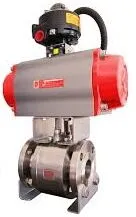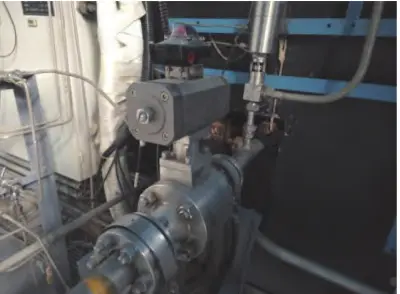Valves for Thermal Power Plant Environmental Protection Equipment
Dec 03, 2024
On this page
Abstract: Valves are critical components in regulating fluid flow within pipelines. Proper valve selection is crucial for ensuring the reliable operation of environmental protection equipment in thermal power plants. Drawing on practical experience, this article outlines the selection criteria and applications of several commonly used valve types.
Valves are essential control devices in fluid pipelines, playing a vital role in power generation and operational processes. Valves are designed to perform a variety of functions, including regulating or stopping fluid flow, preventing backflow, adjusting flow rates and pressure levels, facilitating separation, distribution, and mixing of fluids, maintaining working pressure, and ensuring the safe operation of equipment and uninterrupted pipeline circulation. Valves are versatile and can regulate a wide range of media, including air, water, steam, corrosive substances, and oil.
Valves are essential control devices in fluid pipelines, playing a vital role in power generation and operational processes. Valves are designed to perform a variety of functions, including regulating or stopping fluid flow, preventing backflow, adjusting flow rates and pressure levels, facilitating separation, distribution, and mixing of fluids, maintaining working pressure, and ensuring the safe operation of equipment and uninterrupted pipeline circulation. Valves are versatile and can regulate a wide range of media, including air, water, steam, corrosive substances, and oil.
Valves can be classified according to several criteria, including structural type, driving method, nominal pressure, medium temperature, nominal diameter, and connection method.
- Structural Type: Valves are classified into gate valves, globe valves, ball valves, butterfly valves, check valves, control valves, safety valves, steam traps, pressure-reducing valves, and others.
- Driving Method: Valves are categorized into manual valves (operated by handwheels, handles, levers, or sprockets), electric valves (controlled by electric devices, such as solenoids or actuators), hydraulic valves (operated by liquid pressure), and pneumatic valves (driven by air pressure).
- Nominal Pressure: Valves are classified as vacuum valves (with a nominal pressure below atmospheric pressure), low-pressure valves (up to PN16), medium-pressure valves (between PN16 and PN100, excluding PN16), high-pressure valves (between PN100 and PN1000), and ultra-high-pressure valves (above PN1000).
- Medium Temperature: Valves are categorized as high-temperature valves (above 425°C), medium-temperature valves (between 120°C and 425°C), normal-temperature valves (between -29°C and 120°C), low-temperature valves (between -100°C and -29°C), and ultra-low-temperature valves (below -100°C).
- Nominal Diameter: Valves are classified as small-diameter (less than DN40), medium-diameter (DN50 to DN300), large-diameter (DN530 to DN1200), and extra-large-diameter (greater than DN1400).
- Connection Method: Valves are divided into mechanical connection types and welded connection types. Mechanical connections include flange valves, threaded valves, clamp valves, and ferrule valves.
The gate valve operates through the linear movement of the gate along the sealing surface, which is driven by the valve stem. The main components of a gate valve include the valve stem nut, stand, packing gland, packing, valve bonnet, valve stem, valve seat, closure elements, and valve body. When the gate valve is partially opened, eddy currents may form behind the gate, leading to erosion, vibration, and potential damage to the valve seat sealing surface, making repairs more difficult. Gate valves are typically used in applications where infrequent operation is required, with the gate remaining either fully open or fully closed. They are not suitable for throttling or flow regulation. Gate valves offer advantages such as low fluid resistance, a compact structure, unrestricted flow direction, simple design, and good castability. However, gate valves require a considerable opening height. During operation, friction between the sealing surfaces can cause scratches, adding to maintenance challenges.
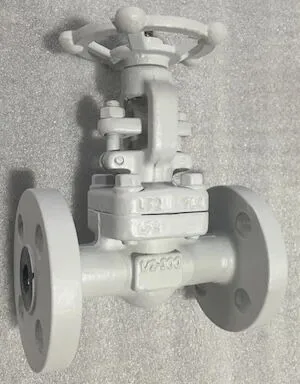

The globe valve operates by moving the valve disc along the sealing surface in a straight line, driven by the valve stem. It primarily consists of a handwheel, valve stem, valve bonnet, valve body, packing gland, packing, valve disc, and sealing seat ring. The globe valve has a relatively small opening height but a longer structural length compared to the gate valve. Its sealing surfaces experience minimal friction, contributing to its durability. However, the globe valve allows unidirectional flow and must be installed accordingly. High fluid resistance may compromise the reliability of the seal during prolonged operation. Closing the globe valve requires significant torque, especially when moving against the flow direction. As a result, globe valves are typically used for opening and closing in pipelines and are not suitable for throttling.
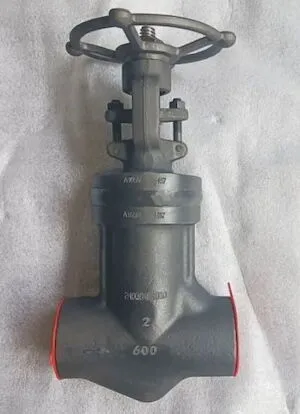

The butterfly valve operates by rotating its disc around the axis of the valve stem, driven by the stem. It primarily consists of a valve body, valve stem, handwheel, valve seat, butterfly disc, and related components. The valve offers several advantages, including a simple structure, compact size, suitability for large diameters, low flow resistance, quick and energy-efficient operation, effective throttling performance, and suitability for low-pressure applications. Modern triple-eccentric, metal-seated butterfly valves, particularly those from certain imported brands, extend service life by eliminating friction between the valve seat and sealing ring during operation. The sealing surface of a triple-eccentric butterfly valve is conically shaped. The valve seat fully engages the butterfly disc's sealing ring, effectively addressing significant leakage in metal-seated valves. This design incorporates a modified sealing structure that uses a torsion seal, achieving a reliable seal without relying on the elastic deformation of the valve seat. The contact surface pressure increases in proportion to the pressure of the medium. As a result, the triple-eccentric butterfly valve offers excellent resistance to both high pressure and high temperatures.
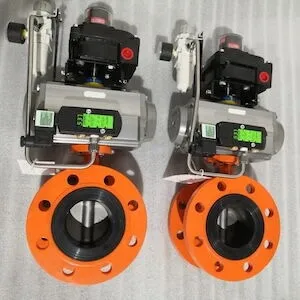

The ball valve operates by rotating its ball around the axis of the valve stem. It primarily consists of a ball, valve body, valve stem, valve seat, rotating mechanism, and related components. Ball valves are known for their simple structure, compact size, lightweight design, significantly shorter height compared to gate and globe valves, low fluid resistance, fast operation, and a sealing surface that minimizes direct contact with the medium, reducing corrosion. They also accommodate a wide range of diameters. However, the ball in a ball valve is difficult to manufacture and grind, and the sealing materials have limitations, which makes these valves unsuitable for high-temperature and high-pressure applications.
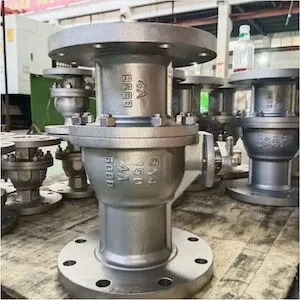
Trunnion ball valves and floating ball valves are commonly used in environmental protection systems in thermal power plants. In a trunnion ball valve, the ball rotates around a fixed axis, with the upper and lower ends remaining stationary. These valves have a complex structure and larger size, making them ideal for applications involving larger diameters or higher pressures. In contrast, floating ball valves allow the ball to move freely without a fixed axis. Under medium pressure, the ball presses against the outlet-side sealing ring, facilitating effective sealing. These valves feature a simpler structure with single-side sealing and are typically used in applications involving smaller diameters and lower pressures.

Trunnion ball valves and floating ball valves are commonly used in environmental protection systems in thermal power plants. In a trunnion ball valve, the ball rotates around a fixed axis, with the upper and lower ends remaining stationary. These valves have a complex structure and larger size, making them ideal for applications involving larger diameters or higher pressures. In contrast, floating ball valves allow the ball to move freely without a fixed axis. Under medium pressure, the ball presses against the outlet-side sealing ring, facilitating effective sealing. These valves feature a simpler structure with single-side sealing and are typically used in applications involving smaller diameters and lower pressures.
Regulating valves are used in applications that require either fully open or fully closed operation in a pipeline. The valve disc adjusts the flow passage area to control the medium's temperature, pressure, and flow. A regulating valve typically consists of a valve body, sleeve, valve core, valve stem, valve bonnet, packing, scale indicator, actuator, and related components. The operating principle of a regulating valve is based on the pressure differential across the valve, which acts on the valve core to generate thrust. This thrust is proportional to the pressure differential and the valve core's cross-sectional area, and it operates in the direction of the medium's flow.
Regulating valves are classified into single-seat, double-seat, and sleeve valves based on their valve core structure. The single-seat valve, the most common type, has one valve core and one valve seat. Its advantages include a simple design, minimal leakage, and a low allowable pressure differential. Single-seat valves are typically used with clean media requiring low leakage and minimal pressure differentials. Double-seat valves feature two valve cores and two valve seats. Compared to single-seat valves of the same size, double-seat valves provide approximately 20–25% greater flow capacity. The fluid forces on the upper and lower valve cores counterbalance each other, though achieving simultaneous closure of both cores is challenging. Consequently, double-seat valves have a high allowable pressure differential but tend to exhibit higher leakage. They are commonly used for clean media where a high-pressure differential exists but minimal leakage is acceptable. However, they are not suitable for use with high-viscosity or fiber-laden media. Sleeve valves incorporate a sleeve that stabilizes the valve core, minimizing movement compared to single-seat designs. This design ensures more stable operation.
Regulating valves are classified into single-seat, double-seat, and sleeve valves based on their valve core structure. The single-seat valve, the most common type, has one valve core and one valve seat. Its advantages include a simple design, minimal leakage, and a low allowable pressure differential. Single-seat valves are typically used with clean media requiring low leakage and minimal pressure differentials. Double-seat valves feature two valve cores and two valve seats. Compared to single-seat valves of the same size, double-seat valves provide approximately 20–25% greater flow capacity. The fluid forces on the upper and lower valve cores counterbalance each other, though achieving simultaneous closure of both cores is challenging. Consequently, double-seat valves have a high allowable pressure differential but tend to exhibit higher leakage. They are commonly used for clean media where a high-pressure differential exists but minimal leakage is acceptable. However, they are not suitable for use with high-viscosity or fiber-laden media. Sleeve valves incorporate a sleeve that stabilizes the valve core, minimizing movement compared to single-seat designs. This design ensures more stable operation.
In conclusion, selecting suitable valves for environmental equipment in thermal power plants requires a thorough understanding of their characteristics and specific applications. Factors such as pressure rating, design temperature, medium properties, and operational requirements must be considered to ensure the valves perform effectively and support efficient plant operation.
Previous: 13th International Valve Trade Fair & Conference 2024
Next: High-Corrosion and Erosion-Resistant Ceramic Valves


